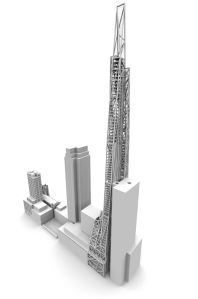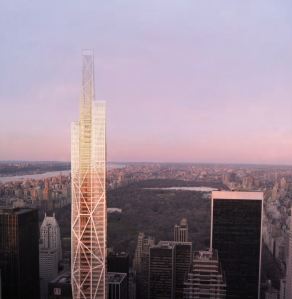
New York City may have brought down Dominique Strauss-Kahn, but another torrid Frenchman will not be held up by the likes of us.
Jean Nouvel, winner of the Pritzker Prize and a severe man even by the standards of his profession, delivered unto the city a “real skyscraper” in 2007. The Torre Verre, more commonly known as the MoMA Tower, would rise to 1,250 feet, an obsidian shard piercing the heart of midtown, built on land traded by the museum to a developer, Hines, for $125 million and three floors of galleries in the base of the new building. A rival to the Empire State Building 20 blocks south, The Times’ Niccolai Ouroussoff called it “the most exhilarating addition to the skyline in a generation.”
Mr. Nouvel, in defending his creation to the City Planning Commission, which was then deciding the outsize tower’s fate, said at a July 2009 hearing, “It’s like music, part of the rhythm of the city and the skyline.” Commission chair Amanda Burden was less taken with Mr. Nouvel’s tune, and knocked 200 feet off the top of the tower, bringing it well south of the Chrysler Building it would have eclipsed (and much closer to its as-of-right height).
Among the issues, she deemed the building’s thorny crown an eyesore for visitors to the Empire State Building, a position that drew outcry from the tower’s legion of worshipers. “Approving the design of Tower Verre while lowering the height was not a compromise but an example of curatorial caution run amok, an attempt to turn midtown into an architectural preserve,” wrote Justin Davidson in New York magazine.

Ms. Burden’s burden not withstanding , like many of the starchitectural erections proposed during the boom, the tower was put on hold, left for dead by some. Hines argued during the approval process that the project simply could not work if not approved at its original height. It would simply be too small to justify the expense of such an ambitious tower. So much for so much.
And yet, this is New York. Expensive real estate can always be justified.
Two weeks ago, Hines quietly filed a new set of plans with the Department of City Planning. They are compliant with two special permits that the commission and the City Council approved in the fall of 2009, which enforce the 1,050-foot height along with restrictions on things like a loading dock for the new building and the museum’s sculpture garden fence—something that has been bothering the neighbors ever since the 2003 renovations. According to a department spokesperson, the application is a chair certification, which does not require public approvals. The process is meant to ensure that the project is in accordance with what was previously agreed upon; a review has no set timeframe.
The resolutions required a tower of similar design proportions. How much the new design resembles the old one, just shorter, is not immediately clear. Initially, Hines said it had filed no new plans, but when The Observer pointed to a notice on the City Planning website, spokesman George Lancaster admitted that the project was back on and imminent. “We DID file revised plans with City Planning for the shorter tower adjacent to MoMA,” he wrote in an email. “We aren’t going to release drawings or details just yet but will in the near future.” He would not say whether the project had financing yet.

MoMA was equally taciturn. “The filing is Hines’ so I don’t have any details on it here. Our plans with regard to the project remain unchanged,” emailed Margaret Doyle, the museum’s communications director. When asked about something Hines would not discuss, the recently acquired Folk Art Museum and how it might factor into the project, she replied, “MoMA has not yet announced any plans for the Folk Art Museum building.”
“Of course for the neighborhood it’s going to be a problem, because it’s a big, tall building,” said Al Butzel, attorney for the Coalition for Responsible Midtown Development, a local community group that filed an unsuccessful suit against the project last summer. “Ten-fifty is better than 1250, but it’s still much more than we wanted, which was 500, closer to the Financial Times building next door.”
Justin Peyser, co-founder of the group, put it more succinctly and cynically in an email: “Our city has always been for sale to the highest bidder and this bid is awfully high.”
In Paris, they forbid tall buildings, too.


